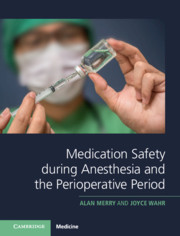Book contents
- Medication Safety during Anesthesia and the Perioperative Period
- Medication Safety during Anesthesia and the Perioperative Period
- Copyright page
- Dedication
- The Snow Vaporizer, Mark II
- Contents
- Foreword
- Acknowledgments
- 1 Introduction to Medication Safety in Anesthesia and the Perioperative Period
- 2 Failures in Medication Safety during Anesthesia and the Perioperative Period
- 3 Failures in Medication Safety in the Intensive Care Unit and Ward
- 4 Impact of Medication Errors on the Patient and Family
- 5 Consequences for the Practitioner
- 6 Why Failures Occur in the Safe Management of Medications
- 7 Errors in the Context of the Perioperative Administration of Medications
- 8 Violations and Medication Safety
- 9 Interventions to Improve Medication Safety
- 10 Medication Safety in Special Contexts
- 11 Legal and Regulatory Responses to Avoidable Adverse Medication Events, Part I: General Principles
- 12 Legal and Regulatory Responses to Avoidable Adverse Medication Events, Part II: Practical Examples
- 13 Barriers to Improving Medication Safety
- 14 Conclusions
- Index
- References
8 - Violations and Medication Safety
Published online by Cambridge University Press: 09 April 2021
- Medication Safety during Anesthesia and the Perioperative Period
- Medication Safety during Anesthesia and the Perioperative Period
- Copyright page
- Dedication
- The Snow Vaporizer, Mark II
- Contents
- Foreword
- Acknowledgments
- 1 Introduction to Medication Safety in Anesthesia and the Perioperative Period
- 2 Failures in Medication Safety during Anesthesia and the Perioperative Period
- 3 Failures in Medication Safety in the Intensive Care Unit and Ward
- 4 Impact of Medication Errors on the Patient and Family
- 5 Consequences for the Practitioner
- 6 Why Failures Occur in the Safe Management of Medications
- 7 Errors in the Context of the Perioperative Administration of Medications
- 8 Violations and Medication Safety
- 9 Interventions to Improve Medication Safety
- 10 Medication Safety in Special Contexts
- 11 Legal and Regulatory Responses to Avoidable Adverse Medication Events, Part I: General Principles
- 12 Legal and Regulatory Responses to Avoidable Adverse Medication Events, Part II: Practical Examples
- 13 Barriers to Improving Medication Safety
- 14 Conclusions
- Index
- References
Summary
Much has been written about human error in the setting of medication safety; much less has been written about violations, which may be equally important and even more common. Violations may vary from and individual's failure to label a syringe to an organization's failure to invest in medication safety. Perhaps the most compelling challenge in this regard is lack of engagement by practitioners in the safety initiatives that exist within their organizations. This chapter includes a discussion of the 4 main reasons for violations: 1) rules must be violated in order for the work to be done; 2) a sense of powerfulness, that one can skillfully complete the job without needing rules; 3) violations represent short-cuts that allow the work to be done better or faster; 4) poor work planning, which results in having to invent the work process as one goes and solve problems as they arise. Reducing violations requires understanding why, and then fixing, the reasons for the violations. An understanding of violation in all its shades and a greater willingness to name this problem and to expect accountability for it within the context of a just culture may well be the key to improving medication safety in the future.
Keywords
- Type
- Chapter
- Information
- Medication Safety during Anesthesia and the Perioperative Period , pp. 130 - 155Publisher: Cambridge University PressPrint publication year: 2021

